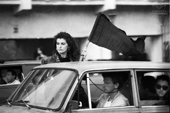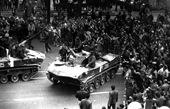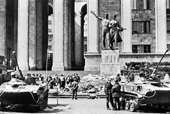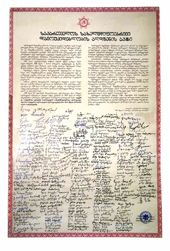
Tragedy of April 9
By Levan Abramishvili
Tuesday, April 9
Today marks the 30 year anniversary of the bloodshed that happened in Tbilisi on April 9, 1989, when the Soviet army inhumanely ravaged the peaceful protesters demanding Georgia’s independence in front of the Parliament building on Rustaveli avenue. As a result, 21 people were killed, among whom 17 were young women.
The date marks one of the most traumatic experiences of the country that has its place in the collective memory of the nation. The protests that led up to the bloody night of 9th begun on April 4th, when peaceful demonstrators gathered to protest the anti-Georgian policies of the central government.
On April 5th the whole city was paralyzed, workers went on strike and educational institutions shut down. On April 7th, the First Secretary of the Georgian Communist Party, Jumber Patiashvili, asked the Central Committee to send reinforcement to reinstate order. On that same day Soviet Army came into Tbilisi.
On the night of 9th, at 4 am Russian troops entered the Rustaveli avenue and violently charged at the protesters, using chemical gas, firearms, shovels and tanks. Thousands were mercilessly beaten and total of 20 people were killed that night, 17 of whom were young women, who stood in front of men in defense, thinking that the troops would spare them, but, unfortunately, the cold-blooded Russians didn’t discriminate when it came to violently beating people. The chemical gas that was used on that bloody night had a lasting effect on the health of the demonstrators. To this day, it is unclear the exact number of casualties that were caused due to do the illnesses caused by the gas. In the morning, a curfew order was issued, to which one man, Gia Karseladze became a victim. He was killed in the street for violating the curfew.
There are hours of footage from the tragic night of April 9th, where one can see the brutal force that was used against the people demanding the independence of Georgia. While the tanks were charging at the demonstrators, several blind musicians were singing Georgian songs, heartening the people facing death. One of the singers was Lela Vepkhvadze, who, over the years became the face and the voice of the April 9 bloodshed. Unfortunately, despite her notoriety, she sings at the metro stations and depends on the good will of the passengers to give her their spare change.
Oftentimes, when such atrocities as the April 9 massacre happens we tend to become numb to the numbers of people killed and forget that behind the numbers there were people whose lives were cut short, their dreams crushed forever. These are the names of the people that were killed that night:
1. Aza Aadamia
2. Natia Bashaleishvili
3. Eka Bezhanishvili
4. Nato Giorgadze
5. Tamuna Dolidze
6. Tina Enukidze
7. Nino Toidze
8. Zaira Kikvadze
9. Manana Loladze
10. Tamar Mamulishvili
11. Venera Metreveli
12. Mamuka Nozadze
13. Nana Samarguliani
15. Marina Tskonia-Samarguliani
16. Eliso Tsipashvili
17. Tamar Tsovelidze
18. Nodar Jangirashvili
19. Mzia Jintsaradze
20. Manana Melkadze
21. Gia Karseladze
April 9th carries two meanings for Georgia – after 2 years from the bloodshed, on March 31, 1991, Zviad Gamsakhurdia’s government held a referendum, where Georgians voted overwhelmingly in favor of independence from the Soviet Union. With a 90.5% turnout, approximately 99% voted in favor of independence. On April 9the Supreme Council of the Republic of Georgia proclaimed Georgian sovereignty and independence from the Soviet Union.





